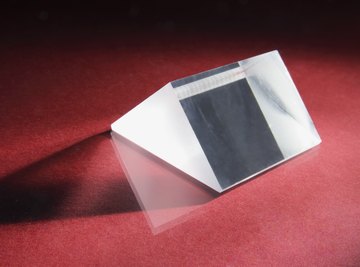
Prisms and pyramids are solid geometric shapes that have flat sides, flat bases and angles. However, the bases and side faces on prisms and pyramids differ. Prisms have two bases -- pyramids only have one. There are a variety of pyramids and prisms, so not all shapes in each category look the same.
Similarities: Common Features
Prisms and pyramids are three-dimensional solid shapes that contain sides and faces that are polygons -- two-dimensional shapes with straight sides. Both shapes fall under the large category -- polyhedrons -- because the sides and bases are polygons. Neither prisms nor pyramids have rounded sides, rounded edges or rounded angles, distinguishing them from cylinders and spheres. All of the side faces meet at the bases -- or at the base in the case of pyramids. Prisms and pyramids come in a variety of sizes, ranging from hand-held objects to grand architectural buildings.
Differences: Bases
The bases on pyramids and prisms differ. Prisms have two congruent -- or identical -- bases, and pyramids only have one base. The shape of the base on pyramids and prisms can vary, depending on the shape of the overall three-dimensional object. For example, the base could have a square, rectangle, triangle, hexagon, pentagon or octagon shape. The base is never a circle or an oval on a prism or a pyramid.
Differences: Side Faces
The side-by-side faces, also known as lateral faces, on pyramids and prisms have different attributes. Prisms have rectangular lateral faces and pyramids have triangular lateral faces. In most cases, the lateral faces of both prisms and pyramids are angled toward the base or bases. The rare exception is the "right prism" -- the faces are perfectly perpendicular to the base. The lateral faces are congruent triangles on a "right pyramid."
Differences: Vertex or Point
Pyramids differ from prisms because they have one central vertex, often referred to as an apex or a point, where the lateral faces meet. The vertex is directly above the center of the base, regardless of the shape of the base. Prisms don't have a vertex because there are multiple meeting points where the faces connect.
About the Author
As curriculum developer and educator, Kristine Tucker has enjoyed the plethora of English assignments she's read (and graded!) over the years. Her experiences as vice-president of an energy consulting firm have given her the opportunity to explore business writing and HR. Tucker has a BA and holds Ohio teaching credentials.
Photo Credits
WestLight/iStock/Getty Images
